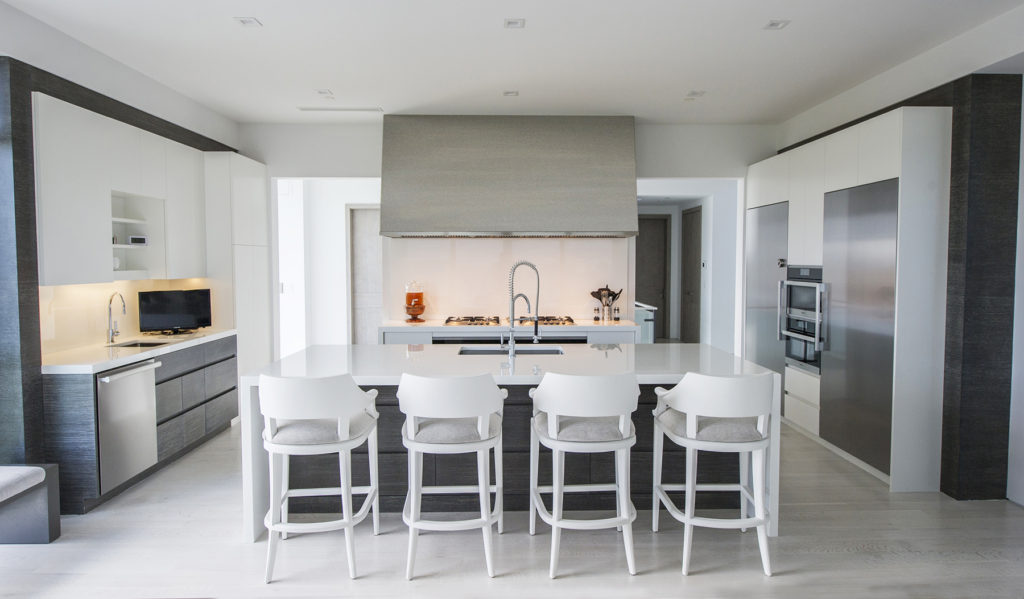
If you are thinking about remodeling or designing a new kitchen space, it is crucial to have an understanding of basic kitchen styles. Read on to learn more about the most common kitchen styles and how they differ in design elements and aesthetic.
TRADITIONAL
Traditional kitchens are elegant and formal, utilizing more of the decorative features and embellishments of classic design than other kitchen styles. Traditional kitchens incorporate detailed millwork, such as decorative moldings and trim, carvings, and corbels in their design. Glazes, antique finishes, or soft, non-glossy finishes are applied to raised, recessed, arched or curved panel cabinetry with large applied moldings and detailed profiles. Traditional kitchen hardware can include decorative, ornamental hardware, distressed or live-finish hardware (such as bronze, iron, copper, or brass) that will achieve a storied, antique look over time. Muted colors such as whites, creams, pastels, or dark wood cabinetry are often utilized in a traditional kitchen. A traditional kitchen will also often showcase an elaborate range hood as the focal point of the kitchen – this may be designed with ornate carvings and details of carved stone or wood. Back splashes tend to be simple, and utilize materials such as natural stone, ceramic tile or rough stone tile.

TRANSITIONAL
Transitional kitchens remain a very popular kitchen style. This style represents a balanced blend of traditional and contemporary design features that result in a clean, streamlined space with typically light, neutral colors. Transitional kitchens emphasize functionality and showcase a more linear style with less embellishments, details, and decorative accents than traditional kitchens. Popular transitional cabinetry is often simple, recessed panel cabinetry, such as shaker style doors, finished with neutral colors of white or gray, or a light natural wood stain. Transitional kitchen hardware is simpler than the ornate hardware of traditional kitchens, and is often selected in a chrome, stainless steel, brass, or bronze finish. Streamlined stainless steel appliances remain a popular choice for transitional kitchens, and range hoods are often simple and sleek, finished to match surrounding cabinetry or designed with metal or wood. Back splashes are typically selected from porcelain tile (such as subway tile), mosaic tile, or natural stone, such as marble. Contemporary lighting, back splash, or hardware choices, as well as mixed finishes can help give a transitional kitchen a trendy, fresh feel, while still paying homage to classic design elements within the space.

CONTEMPORARY
Contemporary kitchen style represents the kitchen style and trends of today; therefore, it is constantly changing and evolving. These kitchens showcase a more minimalist aesthetic, featuring clean, light-filled, spacious layouts, and sleek, simple lines. Flush or slab cabinets, two-toned cabinetry, and mixed finishes and materials are commonplace in these spaces. Finger pulls and touch latches in place of typical hardware are a popular choice in contemporary kitchens, resulting in a cleaner, sleeker aesthetic. Decorative glass, mesh, and laminates are emerging design elements that many designers strive to incorporate in today’s contemporary kitchen. Some popular contemporary colors include saturated, bold colors, black and white, or gray. Range hoods are often designed with slab paneling made from wood, metal, or natural stone to create a unique focal point in the kitchen, and can be made with contrasting colors or materials to add of pop of interest to the space. Smooth, stainless steel appliances are currently a popular option for contemporary kitchen spaces, and are often disguised under slab paneling when possible to maintain an ultra-sleek, minimalist look. Back splash materials can range from natural stone, mosaic, or porcelain, to bolder choices like steel, glass, 3D tile, concrete, or wallpaper.

MODERN
You may think that the style terms “contemporary” and “modern” mean the same thing, but they are a bit different despite their overlapping similarities. Contemporary style, as previously discussed, refers to design trends and styles that are happening in the here and now, while modern style often refers to styles of the 1920’s to the 1960’s. This design style centers on natural materials like wood, metal, stone, and leather, and often utilizes nature-friendly decor. Much like contemporary style kitchens, modern kitchens prize a minimalist aesthetic, with spacious layouts and uncluttered space. Popular modern kitchen style colors include earthy, natural and neutral hues and shades like olive greens, golds, turquoise, browns, and rust – tones with a warm, inviting feel. Cabinetry is often slab style, and both appliances and hardware are selected with a natural metallic finish or are concealed if desired. Range hoods are commonly selected from natural materials such as stone, wood or metal and are designed with a sleek, streamlined appearance to incorporate seamlessly into the kitchen space.



